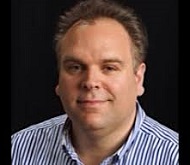 This is an excerpt from an interview with Evan Kirstel that I did for the book that I’m writing on my Bullseye Marketing Framework.
This is an excerpt from an interview with Evan Kirstel that I did for the book that I’m writing on my Bullseye Marketing Framework.
Evan: I’m essentially a one-man — although I do have collaborators – a one man social media marketing agency for B2B tech companies. My clients are vendors and service providers in the enterprise telecomm, cloud, mobile world. From big companies like CenturyLink and Qualcomm to quite a few startups and early stage companies. It’s extending their reach and coverage and capacity to engage on social media, which increasingly is where their customers are spending time, where their partners are, where the events are, where analysts and journalists are.
Louis: So what are the biggest challenges?
Evan: There are still questions about the ROI of social, the measurability of social. There were a lot of skeptics and question marks. And there still is, to a degree, on the value of social in real lead generation, and how do you measure and monetize those activities. But when you look at where people are spending their time, in terms of where customers are, where your analysts and influencers and thought leaders are, increasingly there’s no doubt that they’re just spending more time on social media. And you need to go where they are in this new attention economy. So that’s less of an issue now than in the early days. I think now with analytics you can measure things like click-throughs and website visits. The marketing analytics tools that are available can easily track opportunities and deal flow even, leadgen and top of funnel activities.
Louis: And you’re talking about organic social, not paid social?
Evan: Most of my clients do both. The organic social is critical. They’re mutually supportive. And then paid campaigns can help, too. But in terms of engaging those CIOs [chief information officers], engaging analysts, that really has to happen, in my opinion, organically. People are kind of numb to ads and to paid promotion these days, whereas nothing beats real interaction.
Louis: Have you found those people? Are CIOs on Twitter?
Evan: Yes, increasingly they are. And some of them do it as a sort of career advancing self-promotional thing as well. They have a point of view. And not just social, also blogging, content creation, videos and interviews. And the ones that are in the forefront of this are becoming pretty social creatures and are getting out front of the industry and they’re seen as a thought leader.
Louis: I’ve told you some of my reservations about social media marketing. Thoughts?
Evan: I think the earlier comment of paid versus earned social, I think that requires context. I’m focused on very specific niches, very specific industries, I’m using very targeted hashtags and keywords. If I do occasionally have a strategy of following certain people it’s based on very specific keywords, combinations of keywords. I’m using very complex hashtags; if someone is tweeting around Cisco DevNet Congress, that’s a pretty targeted event. So I’m not worried about stray cats and dogs that I may pick up, who may follow me back. So I think that if I were in B2C marketing like Nike I might agree with that. But if you’re in a very niche market, a very targeted market, an industrial market, you’re hunting with a rifle not a shotgun.
Louis: Good point.
Evan: Secondly, you go for relationships. For me, the value of Twitter and LinkedIn is in that initial awareness, visibility and engagement and turning it into something else: turning it into a face-to-face meeting, a call, a sign-up, a webinar, getting a content view, going to an event. This is all very top of funnel stuff, not some independent thing unlinked to everything else that you’re doing in marketing. So that’s the second thing.
And I think the goal of social is to create and build relationships. There’s this entire watercooler out there and you’re participating in conversation around the watercooler in a very targeted way. And when I get into a conversation around the Internet of Things, there’s a very targeted community of vendors, of consultants, of analysts, of suppliers talking about that. I’m not interested in the macro; I’m very focused on the micro of those conversations.
